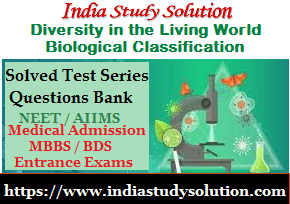Biology Solutions, Solved Test Series, Questions Bank (Practice Questions) for NEET, AIIMS, NTA, NEST
Here you will get very important and most carefully prepared 10 MCQ objective questions in our each Biology Test Series with hints & solutions (given at the end) from the various topics of the unit: Diversity in The Living World - Biological Classification
All these are typically important questions for NEET-UG, AIIMS, JIPMER, COMEDK, MBBS Admission Tests, Medical / Dental Entrance Exams, NEST and other such competitive exams.
The Living World and Biological Classification
Solved MCQ Test Series – Set 5 (Q. No. 41 - 50)
Question 41: In Whittaker classification, algae are included in how many kingdoms
a. 3 b. 2 c. 4 d. All the five kingdoms
Question 42: ‘Taxon’ is the unit of
a. Order b. Taxonomy c. Species d. Genus
Question 43: Protists having non-contractile pusule are
a. Sporozoans b. Ciliates c. Dinoflagellates d. Navicula
Question 44: The stage in which the viral genome gets integrated with the bacterial genome is called
a. Prophage b. Provirus c. Adsorption d. Lysogeny
Question 45: Spicules of class calcarea are –
a. Calcium carbonate
b. Silica
c. Spongin fibre
d. None
Question 46: Which is not a category?
a. Phylum b. Species c. Poaceae d. Class
Question 47: Organism which are found in fresh water as well as in marine environment, they are microscopic and float passively in water current (plankton). Most of them are photosynthetic. The cell form two thin overlapping shell, which fit together as in a soap box.
Organism which possess above character are
a. Dinoflagellates b. Chrysophytes c. Diatoms d. b and c both
Question 48: Kingdom Monera was established by
a. Dougherty b. Copeland c. Stanier d. Heckle
Question 49: The symmetry found in mollusc is:
a. Bilateral b. Asymmetrical c. Biradial d. Radial
(1) a and c (2) b and c (3) d and a (4) a and b
Question 50: Which organisms are not included in the five kingdom system of classification?
a. Protozoans b. Viruses c. Lichens d. Both b and c
India Study Solution
Biology Solutions for NEET, AIPMT, JIPMER, Medical Entrance Exams
Biology: The Living World and Biological Classification
Answers of MCQ Objective Test Series – Set 5 (Q. No. 41 – 50)
Answer 41: (a). Answer 42: (b). Answer 43: (b). Answer 44: (d). Answer 45: (a). Answer 46: (c).Answer 47: (b). Answer 48: (b). Answer 49: (4). Answer 50: (d).
Diversity in the Living World, Biological Classification - Objective Test Series
Check Biology Guide for NEET (AIIMS), MBBS / Dental Admission Tests, Medical Entrance Exams click -
Recommended Study links
- PHYSICS SOLUTION - Free online Test Series, Practice Questions, Notes and Guide for all Engineering, Medical Entrance Exams, JEE Main and Advanced (IIT), NEET (AIIMS, JIPMER)
- Chemistry Solutions - Solved Test Series, Questions Bank, Notes plusStudy Materials for NEET (AIIMS, JIPMER), JEE Main, JEE Advanced (IIT), NEST, MBBS Admission Tests









